header image: Ruth Hartnup – CC BY 2.0
What edible plants grow in Montana?
Many edible plants grow in Montana, such as:
- Clover
- Sweet cicely
- Bergamot
- Purple clover
The wild plants and berries of Montana are great for teas, salad garnishings, pies, jams, preserves, ointments, and even as moth repellant.
Before you taste them, it’s important to know which ones are edible, and which ones aren’t.
Read on for a list of 15 edible Montana plants, with pictures. Discover where to find them, how to identify them, which parts you can eat, and how to prepare them.
Skip to:
- Wild Licorice
- Huckleberry
- Chokecherry
- Gooseberry
- Common Sunflower
- Glacier Lily
- Wild Strawberry
- Cous’ Biscuit-root
- Mountain Bluebells
- Wild Bergamot
- White Clover
- Purple Prairie Clover
- Shortstyle Onion
- Nodding Onion
- Pearly Everlasting
- 437 Edible Wild Plants of the Rocky Mountain West
By the way, check out our gallery-quality photographs of Montana wildflowers available as framed photos, canvas, posters, and more:
15 delicious, edible, wild plants and berries of Montana
Below is a list of 15 wild edible plants and berries of Montana with pictures. The plants and berries on this list are great in salads, teas, stir fries, seasonings, and more.
—–
FDA Disclosure
I am a nature and herbal enthusiast. However, I am not a doctor. Information in this article is for informational purposes only and should not be construed as medical advice. Before using any herbs or plants, check for appropriate dosage, drug interactions, and contraindications. Information contained herein is not intended to treat, diagnose, cure or prescribe. Please consult your primary care physician regarding your specific health concerns.
—–
1. Wild Licorice

Quick facts:
- Latin name: Glycyrrhiza lepidota
- Where to find it: Disturbed, low ground, especially near streams, across all of Montana
- Uses: Roots as a snack, similar in taste to a sweet potato, or as a treatment for coughs, chest pains, and fevers.
- Parts that are edible: Roots
What it looks like
Not to be mistaken for White Clover, Wild Licorice is a wild edible Montana plant that stands about 12 to 47 in (30 – 120 cm) tall, with several branches about 12 in (30 cm) long, each containing 11-19 pointed leaflets.
Around the top are yellowish-white clusters of small, pointed flowers, about 10-15 mm long.
Where to find it
Wild Licorice can be found statewide, usually in wet lowlands, such as in valleys, gravel bars, moist meadows, and thickets along streams and rivers.
How to prepare it
Food
Wild licorice root is long, sweet, and fleshy and serves as a tasty snack when eaten raw or cooked.
The root contains about 6% glycyrrhizin, a natural substance that is about 50 times sweeter than sugar.
As a result, slow-roasted licorice roots are said to taste like sweet potatoes and serve as an excellent flavoring in other dishes.
When chewed raw, the roots serve as an excellent tooth cleaner for children. It’s best to eat the tender young shoots raw in the spring.
Medicine
Like other licorices, this species has many healing properties. However, it has been largely overlooked. While every part of the plant has medicinal properties, the roots are the most potent.
Native North American tribes prepared it in many ways to treat various ailments, such as:
- Tea. Used to treat coughs, fevers, stomach aches, and other common illnesses. They also used it as a wash on swellings. Helps speed up placenta delivery after childbirth.
- Chewed root. Treatment for toothache and sore throats.
- Juice from chewing raw roots. Strengthens the voice of singers.
- Mashed leaves. As a wash for sores.
2. Huckleberry (Montana state fruit)
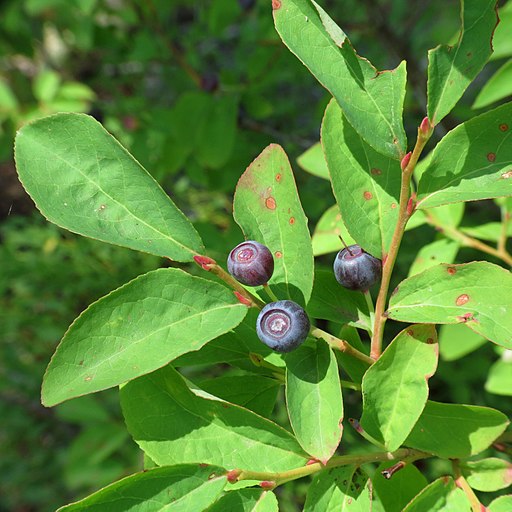
Quick facts:
- Latin name: Vaccinium
- Where to find it: Across western Montana, in the underbrush of low elevations, as well as high, mountainous elevations.
- Uses: As a sweet snack, eaten raw or often in pies. To help lower cholesterol and aid in digestion.
- Parts that are edible: Berry
What it looks like
This wild edible Montana berry is also the state fruit.
Huckleberries are small and round, approximately 5 to 10 millimeters in diameter, and bear resemblance to small dark purple blueberries. They grow on bushes varying in height from 6 inches to 3 feet (18 cm to 1 m) and reproduce with rhizomes.
Where to find it
Huckleberry bushes grow on the forest floor on subalpine slopes, forests, bogs, and lake basins.
They can also be found along mountainsides and alpine lakes and streams in higher elevations, including many of Montana’s state parks.
The best season for picking these wild edible Montana berries in low elevations is middle to late summer, around July. Huckleberries at higher elevations ripen later in the year.
How to prepare it
Food
Red huckleberries are slightly tart, with larger seeds, while the purple ones are sweeter.
While the purple varieties resemble blueberries in appearance, they have a very distinct taste, closer to a blackberry.
One of the most popular ways to prepare huckleberries is to bake them into a pie!
Medicine
Consuming raw or cooked huckleberries has numerous health benefits. This edible Montana berry is high in antioxidants, Vitamin B, and Vitamin C. It is also high in iron, which helps in the production of new blood.
It also helps lower blood cholesterol and aid with digestion. These little berries are packed with nutrition!
3. Chokecherry
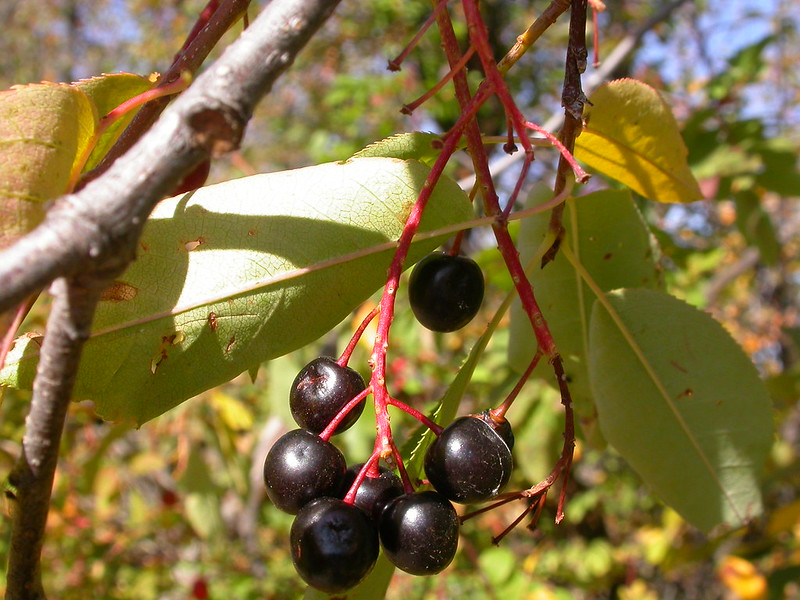
Quick facts:
- Latin name: Prunus virginiana
- Where to find it: Statewide, in a variety of habitats, but slightly more concentrated across all of central Montana
- Uses: As a light snack or ingredient in jams and pies. Tea from the bark is used to soothe a cough
- Parts that are edible: Berries, bark (as tea)
What it looks like
Chokecherries are another of Montana’s distinct edible berries.
Chokecherries grow from shrubs, or small trees with grayish, reddish or creamy white-colored bark. They hang in clusters about 3 to 6 inches (8 to 15 cm) long.
The leaf blades are wide and elliptic with small toothed edges.
Where to find it
Chokecherries can be found statewide, usually near lush rivers and streams in thickets, valleys, forests, and even rocky slopes.
How to prepare it
Food
Chokecherries can be picked and enjoyed raw. They can also be made into various jellies, jams, preserves, and pies.
*note: Chokecherries are sweeter when picked after the first frost. Before the first frost, they can be bitter, hence their name.
Medicine
Chokecherries contain many vitamins like Vitamin C, Vitamin A, Vitamin E, beta-carotene, and folate as well as minerals like potassium and manganese.
100 g of fresh chokecherries provides you with about one-third of your daily recommended Vitamin C.
Chokecherry bark can also be harvested and used as a tea to treat the respiratory system and help soothe a cough. The bark and dried fruit can also stimulate appetite.
4. Gooseberry
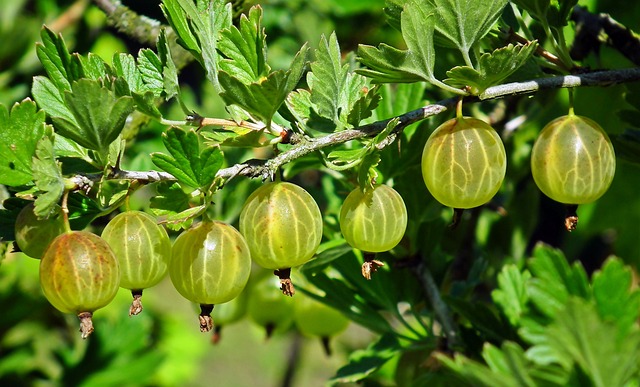
Quick facts:
- Latin name: Ribes oxyacanthoides
- Where to find it: Western Montana
- Uses: Sweet snack alone, or in deserts, pies, jams, and puddings
- Parts that are edible: Berry
What it looks like
Multiple varieties of the Gooseberry grow in Montana (Idaho Gooseberry, Canada Gooseberry, Henderson’s Gooseberry, etc.) and they all look similar.
It is a shrub of about 20 to 60 inches (0.5 to 1.5 meters) in height, with prickly branches, and whitish/pinkish flowers that usually grow alone or in groups of two or three.
The photo above shows clearly what these delicious edible Montana berries look like. They are about 1.5 cm long, and in early summer they are small, lighter-colored (usually green), and veiny.
When they ripen, they turn purple, crimson, or black.
Where to find it
Gooseberries can grow anywhere in Montana, though they are commonly found near riverbanks.
How to prepare it
Food
The bitter varieties, or unripe gooseberries, are often used for cooking. They are often made into pies, jams, and puddings.
The ripe, sweet varieties are delicious when eaten raw and are often used in deserts.
Medicine
In addition to being packed with vitamins, antioxidants, and flavanols, this edible Montana berry also serves as a mild laxative.
When boiled, they can help with kidney problems or uterine troubles in women.
5. Common Sunflower

Quick facts:
- Latin name: Helianthus annuus
- Where to find it: Statewide, in grasslands, plains, valleys, and near streams
- Uses: Sunflower-leaf tea helps reduce fever. Leaf poultices soothe sores, insect bites, and swellings. Seeds help with strength and immunity
- Parts that are edible: Seed, flower
What it looks like
The Sunflower is one of the most common edible plants of North America, with a distinct appearance. Like a giant daisy, the sunflower has bright yellow leaves that radiate from a dark center that ripens and fills with seeds.
They always face the sun throughout the day, hence their name.
Where to find it
Sunflowers can be found across the entire state of Montana.
While commercial crops grow in eastern Montana, the wild varieties are found in most counties across the state.
How to prepare it
Food
If you stumble upon a ripe sunflower in nature, pull the seeds from the center and enjoy.
Or take them home and salt or roast them.
After cleaning the stalks you can eat the stalks as you would celery sticks and dip them into cream cheese or peanut butter.
Or, cook young sunflower buds like you would an artichoke. Cook them until they’re tender, and flavor with oil, salt, or pepper.
Medicine
- Seeds help relieve coughs and pulmonary infections
- Oil helps reduce internal dryness and constipation
- Leaf tea helps reduce fever
- Leaf poultice help soothe sores from insect bites, such as spider bites
Buy gallery-quality photographs of Montana wildflowers:
6. Glacier Lily

Quick facts:
- Latin name: Erythronium grandiflorum
- Where to find it: In subalpine and mountain elevations of western Montana
- Uses: Mashed roots help heal skin sores, and corms treat colds and respiratory illnesses
- Parts that are edible: Stems, leaves, roots, corms, and bulbs
What it looks like
The Glacier Lily features a single or double flower blossom atop a leafless stem that curves down at the top, causing the flower to face down.
The flowers of this delicate edible Montana plant feature six curved petals that reveal white, yellow, purple, or brown stamens (the “antennas” coming from the center of the flower).
Several long, green, curved leaves grow from the base of the plant.
These are small plants that grow close to the ground in the mountainous regions of Montana, ranging from 4 to 16 in (10 to 40 cm) in height.
Where to find it
Glacier lilies often grow in large patches in moist soils, such as along stream banks, in shaded forests, and in meadows.
These brilliant flowers follow the receding snowline in the spring from the valleys up to higher elevations.
How to prepare it
The corms are one of the most commonly consumed parts of the Glacier Lily, and they are a delicacy for bears. They were also a staple in the Blackfeet tribe’s diet.
Food
- Corms are edible raw, like an onion, but may not appeal to many people
- Corms are sweeter when roasted, glazed, or boiled (like onions)
- Boiled corms make a great addition to soup
- Cooked seed pods are also a tasty side dish or additional ingredient to various savory dishes, with a taste similar to green beans
- Leaves serve as a delicious addition to salads or a garnish on other savory dishes
Medicine
- Pulverized root has been said to help with skin sores
- Consuming corms is said to help with common colds and other upper respiratory infections as well as fevers and swelling
7. Wild Strawberry
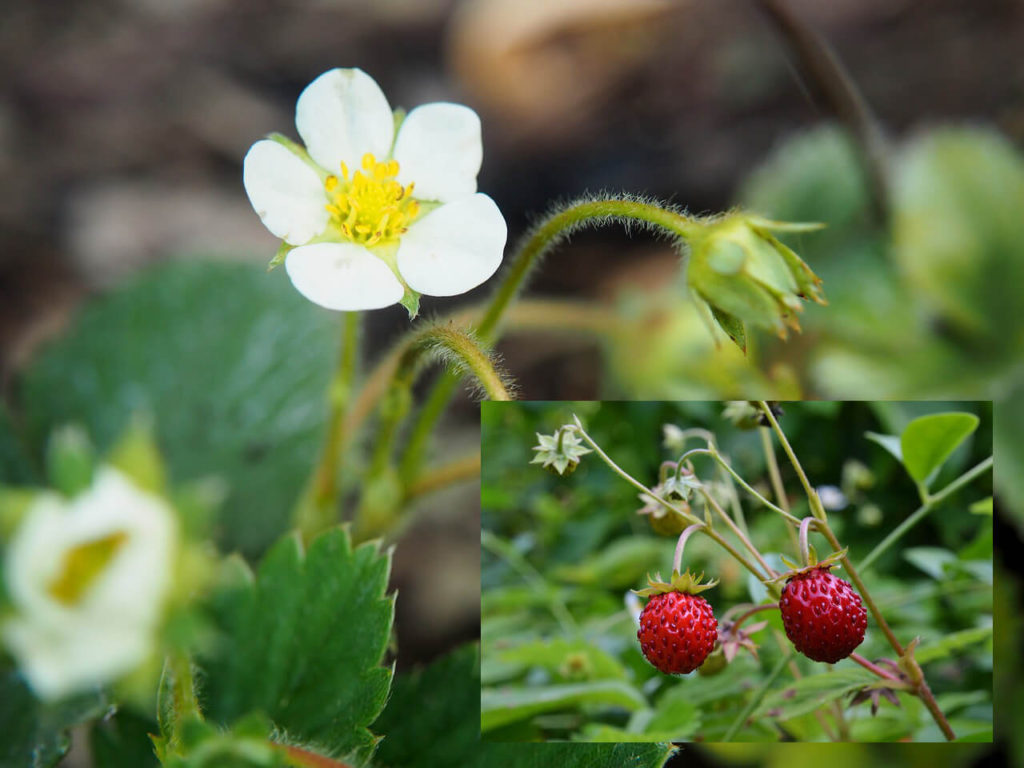
Quick facts:
- Latin name: Fragaria vesca
- Where to find it: Statewide, in thickets, forests near rivers, valleys, and mountain regions
- Uses: Snack, laxative
- Parts that are edible: Berry
What it looks like
These edible Montana berries are smaller, and more round-shaped than store-bought strawberries.
The flowers have five white petals. The ones with yellow flowers are a different variety, with a bland and watery taste that can produce a mild reaction in some people.
The leaves consist of three leaflets with toothed edges.
Where to find it
Wild strawberries grow statewide in Montana. You can often find them in forested areas near rivers and in clearings, but they also grow in mountain and valley thickets.
Some people claim they find them most often on the edge of forests.
How to prepare it
Food
Enjoy these intensely flavored wild strawberries as you would store-bought strawberries – on yogurts, cereal, and salads or as a snack by themselves.
Medicine
- Native American tribes used tea from the green leaves to help relieve kidney and stomach trouble
- The berries are a great source of vitamin C
- Native tribes created a juice by mixing the berries with water, which they applied it to sunburns
8. Cous’ Biscuit-root
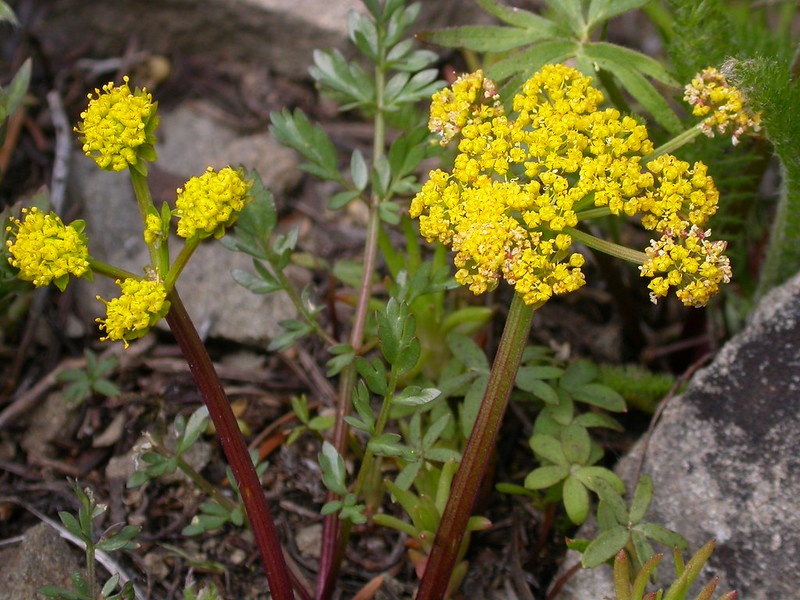
Quick facts:
- Latin name: Lomatium cous
- Where to find it: Statewide, except the northeast and northwest corners, in dry, open slopes and flats, often among sagebrush
- Uses: Nonmedicinal, often ground into flour for cakes. Roots baked and eaten like potatoes
- Parts that are edible: Roots
What it looks like
The Cous is a short, wild, edible Montana plant, about 5 inches (13 cm) tall at maturity, with a thick stem and bright yellow flowers that grow in clusters.
Where to find it
This bright little plant grows in dry, rocky fields, making it easy to spot. However, for the same reason, the roots can be difficult to dig up.
How to prepare it
Food
This edible Montana plant was a staple in the Nez Perce diet, who often ground the roots into flour. While tasteless, it works well for cakes.
The roots can also be baked and eaten like potatoes.
Medicine
We couldn’t find any medicinal uses for Cous’ Biscuit Root.
9. Mountain Bluebells

Quick facts:
- Latin name: Mertensia ciliata
- Where to find it: Western, mountain region of Montana. In grasslands and woodlands, from valleys to alpine.
- Uses: In folk tales, the bulbs were used as diuretics (to increase urination) and Native tribes used them to help in producing mother’s milk.
- Parts that are edible: Flowers, leaves, bulbs
What it looks like
The bright Mountain Bluebell is an unmistakable edible plant native to Montana.
This edible Montana plant grows about 3 feet (1 m) tall. Its leaves are a bluish-green color with lateral veins, and the flowers are small, bright blue, and bell-shaped, drooping downward.
The flowers grow in open clusters and when they blossom in the spring, they light up the area in which they grow with their distinct color.
Where to find it
Mountain bluebells prefer moist, unsalinated soil. Therefore, they often grow along streams, in damp thickets, or in wet meadows at higher elevations – from 5,000 ft to 12,000 ft (1,524 m to 3,658 m).
How to prepare it
Food
The flowers and leaves can be eaten raw (for example, as a garnish) or used to make tea.
Medicine
In traditional medicine, the bulbs were reported to be a diuretic (which increases urination).
Native tribes of North America used them to aid in lactation in nursing mothers.
10. Wild Bergamot (aka Bee Balm)

Quick facts:
- Latin name: Monarda fistulosa
- Where to find it: Statewide in a variety of habitats, often in dry fields and thickets, and clearings with limy soils
- Uses: As a delicious tea or garnish. Native tribes used it to treat fever, sore eyes, and common colds
- Parts that are edible: Flowers, leaves
What it looks like
Like other wild edible Montana plants in the mint family, Wild Bergamot has a square-shaped stem.
Mature plants stand 2 to 4 ft (0.6 to 1.3 m) tall, with clusters of pink or purple, pointed flowers, grouped together in a sphere-shaped cluster (see photo).
Where to find it
This wild edible Montana plant grows statewide in a variety of habitats, but it is most commonly found in dry fields, thickets, and clearings as well as wet meadows and ditches.
How to prepare it
Food
The leaves are the most commonly eaten part of the plant and have the strongest flavor.
Here are common ways to prepare Wild Bergamot:
- Dried leaves as herbs
- Dried leaves as tea
- Leaves as flavorings or garnish in salads
- Flowers as a colorful garnish in salads
- Dried flowers as tea
The entire plant can be used as greens for your favorite salad. However, it is highly aromatic, and the taste can be too strong for some people.
Medicine
The native Tewa tribe of the southwestern United States dried the plant, ground it into a powder, and applied it to the head to help ease headaches, fever, sore eyes, and common colds.
American settlers sometimes used it to help with nausea and vomiting.
11. White Clover

Quick facts:
- Latin name: Trifolium repens
- Where to find it: Often grows in fields, along roadsides, and even on lawns
- Uses: Tea has been used to treat coughs, fever, and colds
- Parts that are edible: The entire plant – leaves, stems, flowers, and seed pods
What it looks like
Clover slightly resembles Wild Bergamot. However, the flowers of Clover are distinctly different – they are more pointed and spear-shaped, whereas Bergamot flowers have a more flat-shaped petal.
Clover leaflets are round-shaped and usually grow in groups of three.
Where to find it
This edible Montana plant is often found in open, moist fields. It’s particularly common near towns, along roadsides, and even on lawns.
How to prepare it
Food
Dried White Clover flowers make wonderful tea and are also great for jellies.
Fresh flowers and greens make for excellent garnishes on salads and desserts.
They can also be baked into cookies, creating a unique summer flavor.
Medicine
Native tribes used White Clover tea to treat fevers, coughs, and colds.
12. Purple Prairie Clover

Quick facts:
- Latin name: Dalea purpurea
- Where to find it: In grasslands of plains and valleys, most common in central and eastern Montana
- Uses: Leaves and blossoms have been used to treat stomach aches and measles.
- Parts that are edible: Leaves and roots
What it looks like
The Purple Prairie Flower is easily recognizable with its cone that sits at the end of a tall stock, wrapped in cylindrical spiked flowers.
A bundle of brightly-colored purple flower petals wrap around the base of the cone.
Mature plants reach 1 to 3 feet (0.3 to 1 m) tall.
Where to find it
It usually grows in grasslands, plains, and valleys with moist soils.
How to prepare it
Food
- Native Americans ate the leaves, fresh or boiled
- Dried leaves make a great tea
- Roots can be chewed for their pleasant flavor
Medicine
In traditional medicine, Native tribes would use this edible Montana plant to create the following:
- A poultice (thick paste) from the steeped leaves to treat wounds (though there is no scientific evidence proving that it works, and we advise against trying it)
- A decoction (boiled paste) from the leaves and blossoms to treat diarrhea and measles (But again, there is no scientific evidence that it works)
13. Shortstyle Onion (Short-stem Onion)

Quick facts:
- Latin name: Allium brevistylum
- Where to find it: In swampy meadows and along streams at medium and high elevations
- Uses: For treating coughs and bee stings
- Parts that are edible: Bulb, leaves, stem, root
What it looks like
As you can see from the photo, the Shortstyle Onion has purple, elongated flowers with pointed petals at the opening.
Mature plants reach 8 to 24 inches (20 to 61 cm) tall.
Where to find it
It usually grows in moist meadows, ridgelines, and along streams in the mid to high elevations across Montana. It rarely grows on wooded slopes.
Because it can thrive in higher elevations, we consider the Shortstyle Onion a distinct Rocky Mountain edible plant.
How to prepare it
Food
The bulb and leaves are edible raw or cooked, though they have a strong onion or garlic odor.
People commonly add them to soups and stews or use them as a garnish for salads.
Medicine
- The entire plant repels insects and moles, so it has traditionally been used to create moth-repellent
- Native tribes would crush it and apply it to bee and insect bites
- Native tribes would also create a heavy syrup from the juice of the onion and use it to treat cold symptoms
14. Nodding Onion

Quick facts:
- Latin name: Allium cernuum
- Where to find it: Across much of the state in dry, open areas, from the plains to the mountains
- Uses: Similar to garlic, a poultice (paste) has been said to aid in respiratory ailments and the juice has been said to aid with kidney stones
- Parts that are edible: Bulbs, leaves, flowers
What it looks like
This bright little flower stands about 4 to 20 inches (10 to 50 cm) tall, curved down at the top. It has groups of dusty pink flowers, about 1cm long, pointing down, each with about 6 pointed petals.
Where to find it
The Nodding Onion is an edible plant that is native to Montana and widespread across the state. It is often found in dry, open areas and at the edge of forests, from the prairie to the mountains.
How to prepare it
Food
This edible Montana plant is simply delicious, with a flavor similar to a traditional onion.
Due to its strong flavor, it’s often used as a flavoring for other dishes. Cooking it softens the strong flavor, and turns it slightly sweet.
Here are some simple preparation suggestions for the Nodding Onion:
- Bulbs can be eaten raw, cooked, or dried for the winter
- Leaves are edible raw or cooked and have a delicious onion flavor that is great for salads
- Flowers can also be eaten raw or cooked and have a stronger onion flavor than the leaves, making for a colorful and delicious addition to salads
- Fry any part of them up in a stir fry to spruce up your recipe with a wild onion flavor!
Medicine
The juice from the Nodding Onion has also been used to treat respiratory ailments and kidney stones and as an effective moth repellant!
A poultice (paste) from the plant has also been used to treat infections such as sore throats, sores, and swellings (though we found no medical evidence to back this up).
15. Pearly Everlasting

Quick facts:
- Latin name: Anaphalis margaritacea
- Where to find it: In central and western Montana in meadows, forests, clear-cuts, and roadsides in subalpine regions
- Uses: As an antiseptic to treat sores, and in steam baths for rheumatism
- Parts that are edible: Young plants and older leaves
What it looks like
This wild edible Montana plant has a slender, fuzzy stem and slim, pointed leaves of a distinct grey-green color that alternate their way up the stem.
White clusters of small flowers appear in late spring. As they bloom, they reveal a fuzzy, yellow-orange center.
The leaves and flowers give off a sweet, earthy aroma. Mature plants can reach 3 ft (1 m).
Where to find it
A true Rocky Mountain edible plant, Pearly Everlasting usually grows in subalpine elevations, in disturbed soils in either sunlight or shaded areas.
You can often find them on mountain roadsides, meadows, forests, and clear-cut fields.
How to prepare it
Food
The fuzziness of this plant makes it unappealing to many people. For the best quality and taste, harvest this plant in mid-summer before the flowers bloom.
Here are several ways to enjoy this plant:
- Cooked, older leaves make a great potherb
- Leaves also make a tasty and nutritious tea
- Dried flowers make a great oil infusion (this website has great instructions for making herb-infused oils)
Medicine
Native tribes of this region often used Pearly Everlasting in various ways, including:
- As a poultice for treating sores
- As a tea or a steam bath for rheumatism
- As an antiseptic for open wounds
Purchase gallery-quality photographs of Montana wildflowers:
Montana edible weeds, berries, and mushrooms
Below you can brief lists of edible weeds, berries, and mushrooms that also grow in Montana.
Montana edible weeds
Below you can find pictures of Edible weeds that grow in Montana.
1. Dandelion

2. Purslane

3. Thistle
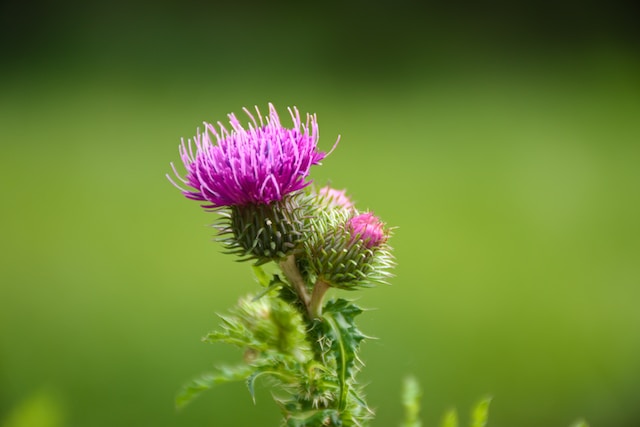
4. Clover
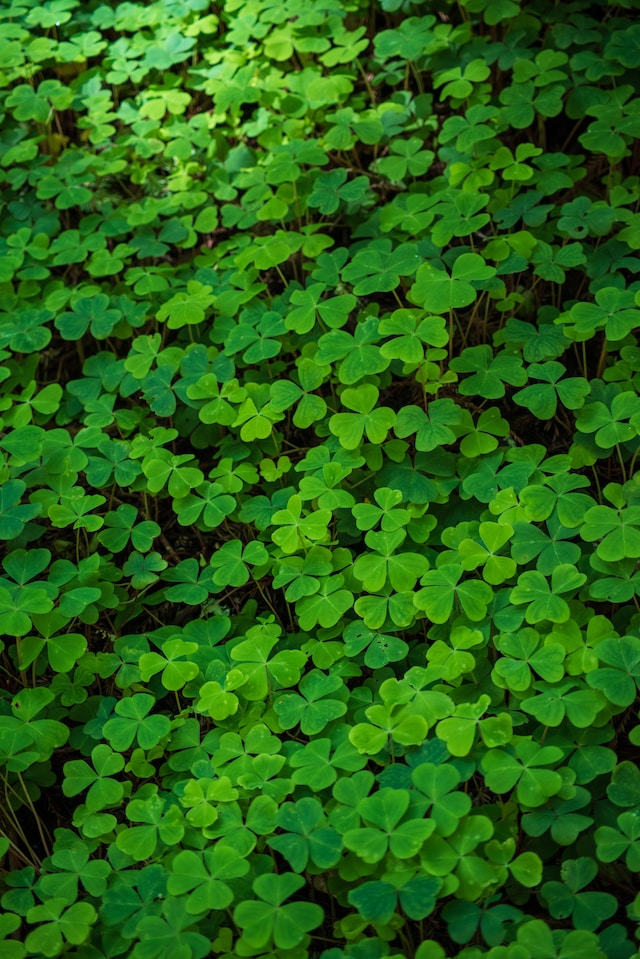
5. Mustard

6. Burdock root

Montana edible wild fruit
Below is a list of some more wild edible Montana berries:
1. Rosehips

2. Wild Plums

3. Hawthorn

4. Juniper Berry

Montana edible wild mushrooms
Below you can find a list of wild, edible mushrooms that grow in Montana:
1. Morels

2. Oyster

3. Hedgehog

Get the complete guide to edible plants of the mountain states
Are you interested in learning more about wild edible plants that grow in the mountain states?
437 Edible Wild Plants of the Rocky Mountain West is an extremely well-written edible plants book covering edible and medicinal plants of Arizona, Colorado, Idaho, Montana, Nevada, New Mexico, Utah, and Wyoming.
It includes over 1,450 photographs of 437 edible wild flowers, greens, roots, nuts, and berries, with invaluable information on identification, flavor, preparation instructions, and much more. It’s one of the most comprehensive books of this genre.
Get it from Amazon here.
Disclaimer: The contents of this article are for educational purposes only. Before ingesting ANY herb or plant from the wild, please ensure you correctly identify it or consult a professional wild plant harvester for advice.
This content is accurate and true to the best of the author’s knowledge and does not substitute for diagnosis, prognosis, treatment, prescription, and/or dietary advice from a licensed health professional. Drugs, supplements, and natural remedies may have dangerous side effects. If pregnant or nursing, consult with a qualified provider on an individual basis. Seek immediate help if you are experiencing a medical emergency.









